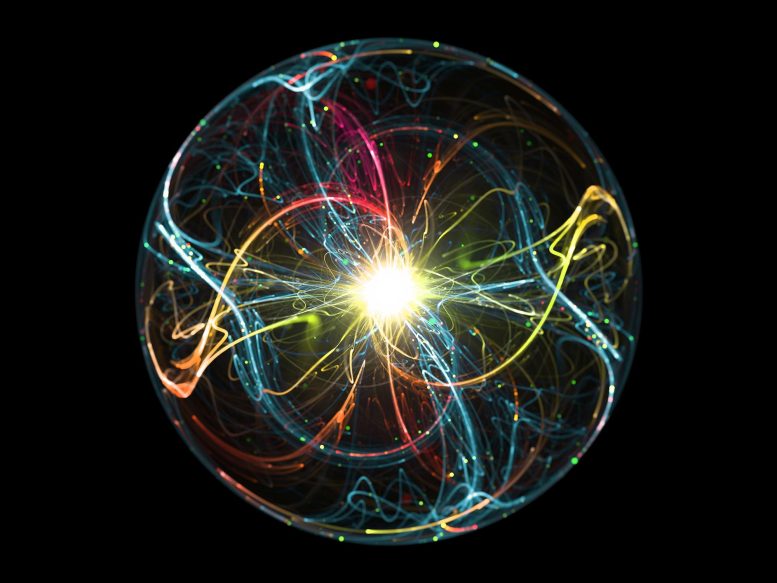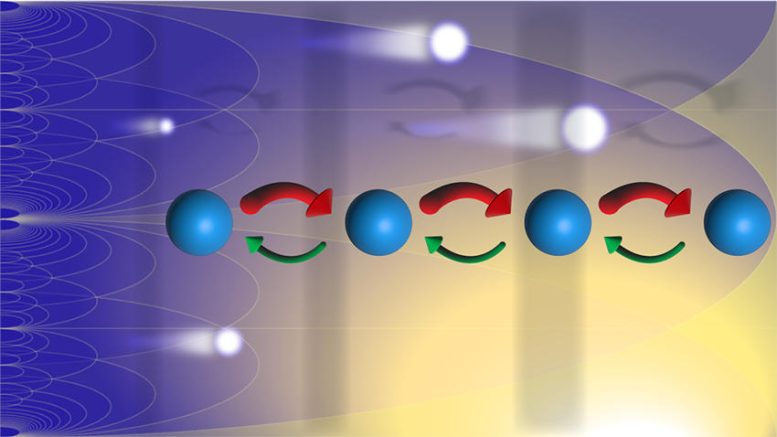
A Physics Puzzle Is Resolved Through a New Duality
According to traditional thinking, distorting a flat space by bending it or stretching it is necessary to create a curved space. A group of scientists at Purdue University has developed a new technique for making curved spaces that also provides the answer to a physics mystery. The team has developed a method using non-Hermiticity, which occurs in all systems coupled to environments, to build a hyperbolic surface and a number of other prototypical curved spaces without causing any physical distortions of physical systems.
“Our work may revolutionize the general public’s understanding of curvatures and distance,” says Qi Zhou, Professor of Physics and Astronomy.
“It has also answered long-standing questions in non-Hermitian quantum mechanics by bridging non-Hermitian physics and curved spaces. These two subjects were assumed to be completely disconnected. The extraordinary behaviors of non-Hermitian systems, which have puzzled physicists for decades, become no longer mysterious if we recognize that the space has been curved. In other words, non-Hermiticity and curved spaces are dual to each other, being the two sides of the same coin.”

The team’s results were published in the journal Nature Communications in an article titled “Curving the Space by Non-Hermiticity.” Most of the team’s members are employed at Purdue University’s West Lafayette campus. The Purdue team is made up of Professor Qi Zhou, Zhengzheng Zhai, a postdoctoral researcher, with graduate student Chenwei Lv serving as the primary author. Professor Ren Zhang from Xi’an Jiaotong University, who is a co-first author of the paper, was a visiting scholar at Purdue when the study was originally started.
One must first comprehend the distinction between Hermitian and non-Hermitian systems in physics in order to comprehend how this discovery works. Zhou explains it using the example of a quantum particle that can “hop” between several locations on a lattice.
If the probability for a quantum particle to hop in the right direction is the same as the probability to hop in the left direction, then the Hamiltonian is Hermitian. If these two probabilities are different, the Hamiltonian is non-Hermitian. This is the reason that Chenwei and Ren Zhang have used arrows with different sizes and thicknesses to denote the hopping probabilities in opposite directions in their plot.
Non-Hermitian Quantum Systems
“Typical textbooks of quantum mechanics mainly focus on systems governed by Hamiltonians that are Hermitian,” says Lv.
“A quantum particle moving in a lattice needs to have an equal probability to tunnel along the left and right directions. Whereas Hermitian Hamiltonians are well-established frameworks for studying isolated systems, the couplings with the environment inevitably lead to dissipations in open systems, which may give rise to Hamiltonians that are no longer Hermitian. For instance, the tunneling amplitudes in a lattice are no longer equal in opposite directions, a phenomenon called nonreciprocal tunneling. In such non-Hermitian systems, familiar textbook results no longer apply and some may even look completely opposite to that of Hermitian systems. For instance, eigenstates of non-Hermitian systems are no longer orthogonal, in sharp contrast to what we learned in the first class of an undergraduate quantum mechanics course. These extraordinary behaviors of non-Hermitian systems have been intriguing physicists for decades, but many outstanding questions remain open.”
Non-Hermitian Hamiltonians and Curved Spaces
He further explains that their work provides an unprecedented explanation of fundamental non-Hermitian quantum phenomena. They found that a non-Hermitian Hamiltonian has curved the space where a quantum particle resides. For instance, a quantum particle in a lattice with nonreciprocal tunneling is in fact moving on a curved surface. The ratio of the tunneling amplitudes along one direction to that in the opposite direction controls how large the surface is curved.
In such curved spaces, all the strange non-Hermitian phenomena, some of which may even appear unphysical, immediately become natural. It is the finite curvature that requires orthonormal conditions distinct from their counterparts in flat spaces. As such, eigenstates would not appear orthogonal if we used the theoretical formula derived for flat spaces. It is also the finite curvature that gives rise to the extraordinary non-Hermitian skin effect that all eigenstates concentrate near one edge of the system.
Practical Applications of the Research
“This research is of fundamental importance and its implications are two-fold,” says Zhang. “On the one hand, it establishes non-Hermiticity as a unique tool to simulate intriguing quantum systems in curved spaces,” he explains. “Most quantum systems available in laboratories are flat and it often requires significant efforts to access quantum systems in curved spaces. Our results show that non-Hermiticity offers experimentalists an extra knob to access and manipulate curved spaces.
An example is that a hyperbolic surface could be created and further be threaded by a magnetic field. This could allow experimentalists to explore the responses of quantum Hall states to finite curvatures, an outstanding question in condensed matter physics. On the other hand, the duality allows experimentalists to use curved spaces to explore non-Hermitian physics. For instance, our results provide experimentalists a new approach to access exceptional points using curved spaces and improve the precision of quantum sensors without resorting to dissipations.”
Now that the team has published their findings, they anticipate it spinning off into multiple directions for further study. Physicists studying curved spaces could implement their apparatuses to address challenging questions in non-Hermitian physics.
Also, physicists working on non-Hermitian systems could tailor dissipations to access non-trivial curved spaces that cannot be easily obtained by conventional means. The Zhou research group will continue to theoretically explore more connections between non-Hermitian physics and curved spaces. They also hope to help bridge the gap between these two physics subjects and bring these two different communities together with future research.
According to the team, Purdue University is uniquely qualified to foster this type of quantum research. Purdue has been growing strong in quantum information science at a fast pace over the past few years. The Purdue Quantum Science and Engineering Institute paired with the Department of Physics and Astronomy, allows the team to collaborate with many colleagues with diverse expertise and foster interdepartmental and collegiate growth on a variety of platforms that exhibit dissipations and nonreciprocal tunneling.
Reference: “Curving the space by non-Hermiticity” by Chenwei Lv, Ren Zhang, Zhengzheng Zhai, and Qi Zhou, 21 April 2022, Nature Communications.
DOI: 10.1038/s41467-022-29774-8
Never miss a breakthrough: Join the SciTechDaily newsletter.
14 Comments
Distant galaxies to be visible from 13,500,000,000 years ago seems 100% Flat and Unlimited!? Unless our version of Time/Space is Limited which cannot explain Pi!?
Non-Hermiticity and curved spaces are dual to each other, being the two sides of the same coin. This is very good! The same situation is also manifested in the topological vortex field. Left rotation and right rotation are the two sides of the same space-time vortex.
I see that the two previous commenters saw the same probabilities as I did, while I was reading the article, I the example given, between two dimensional and three dimensions; If we address the same scenario from a three dimensional to a four dimensional mathematical point of view; ignoring momentarily the whole “space-time issue” and accepting, for arguments sake that the universe is four dimensional, not just three; wouldn’t the computationally observed universe explain the apparent expansion of this space, because we fail to account for the fourth dimension just because we normally don’t recognize it, although, obviously, it’s there? Four dimensions plus time?
Whoever Hermit is, he seems to dislike Hamilton…
Does prc run Purdue?
I’m not sure who the intended audience the author was trying to inform but it wasn’t me. Still the clickbait title was effective.
I took this seriously at first. Kept, reading… was like uh huh okay get to the point. Then I realized this was just an undergrad who tossed this bad boy together at 2am lol. Clickbait… remember reputation is always important when it comes to people trusting your information. I’d delete and just get better.
I’m not sure just what the PRC is trying to say here? Do they now believe that they’re curving space in much the same way that matter curves space? That is, if I were to shine an [ultra thin cosmic ray laser having sufficiently narrow wavelength] through this region of curved space that the laser would be deflected? After all, the structure of space is determined by matter…
Therefore, if the PRC arm of Perdue is correct here we should be making tiny black holes in no time lmao
NETTER KEEP CHINA AWAY! They will steal it. Is this one of the Universities that had their spies in it.
This would be like sitting at your desk in Hiroshima commenting on this article; then a bright flash of light and it’s not even the last thing you remember, because death came just that fast.
This was explained thousands of years ago by God… but nobody believes him.
Exodus 36:24
And forty sockets of silver he made under the twenty boards; two sockets under one board for his two tenons, and two sockets under another board for his two tenons.
Well. This study needs two more minutes to be undertood… Hopefully that in English there is only one word to define a “direction” where in French e.g. there are two : the “sens” (left or right) is different from the direction.
Why is the word non hermiencity out of skew and typeface in this article?, it’s way off
…
okay, there is a question about time and space as the same direction, regarding getting into the shape!
Lets say that you run and that you move you self in the space. Then the outcome is that you lose some weight. However, if you sit in your chair you don’t lose the weight. I try both approaches and it is how it works… don’t believe those calculators …. So! If you sit in your chair you still move in time, but you don’t lose your weight. Then time is not a dimension like space is…